Discovering Central Europe: Slovakia
by Kerlyn Tan
@ 29 Mar 2018
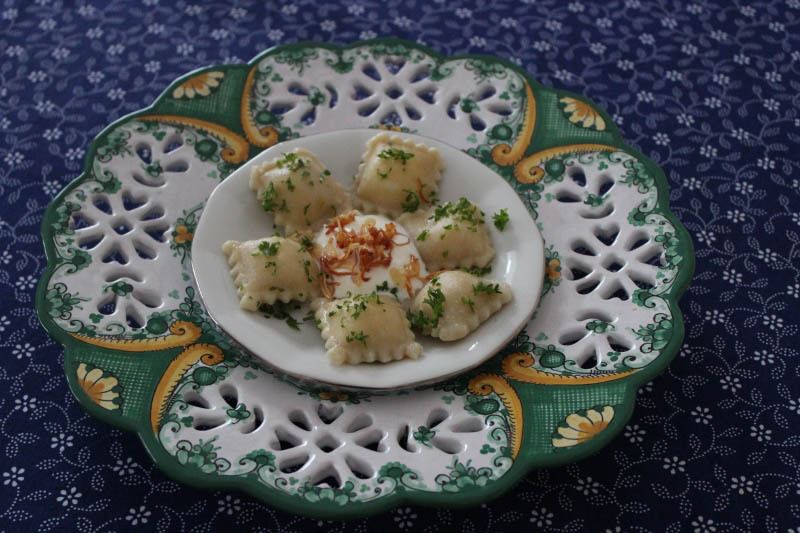
When certain cuisines are mentioned, your brain will conjure up the most famous dishes; the flavours you’re craving or of the ones you’ve recently encountered. In Singapore, it would be the Chinese dumplings and chicken rice, the Pernanakan laksas, the Eurasian singgangs, the Indian rotis and curries and the Malay rendangs and satays. Travel up to top tourist destinations in Europe and you’ll get to taste French bouillabaisse, onion soup, coq au vin; Italians with their Parma ham, truffle risotto and pastas; numerous German sausages and berliners; Spanish paellas and churros… the list is endless. Now, those are mostly on the western side of Europe. What about Central Europe? Any dishes spring to mind? If not, that’s a real shame. Keeping this factor in mind, the World Gourmet Summit (WGS) 2018 has decided to highlight some parts of Central Europe, with their theme: “The Discovery WGS.” We’ve decided to shadow this and spoke to six countries within Central Europe. The ambassadors gave quotes on how their nation’s agriculture is developing while the chefs share about the gastronomic scene.
Discovering Slovakia: Ancestral Traditions
There were numerous migrations between Hungary, Germany, Romania and Slovakia during the 11th and 15th centuries resulting in mixed ancestry within Slovakia. Due to their topographic disposition, Slovak cuisine were strong self-reliant on staple foods that withstand the harshness of winter and the heat of summer. This included potatoes, milk, eggs, vegetables and certain wild mushrooms. The meats were to some lesser degrees, beef, poultry and lamb. These products were all processed by the families and led to them trading in local markets.
Michal Slivovič, the Ambassador of Slovakia to Indonesia, Singapore, Brunei, The Philippines, Timor-Leste, Malaysia and ASEAN tells us:
DD:What are the main focuses of agriculture and livestock in Slovakia?
His Excellency: It is important to mention that Slovakia is not an agricultural country and agriculture forms just around 3,6% of GDP. Over 40% of the land is cultivated. Wheat, rye, corn, potatoes, sugar beets, grains, legumes, fruits, vegetables, sunflowers and hops are grown. Vineyards are also important for the country and there are six wine growing regions located in Slovakia. The breeding of livestock, including pigs, cattle, sheep, and poultry is also important.
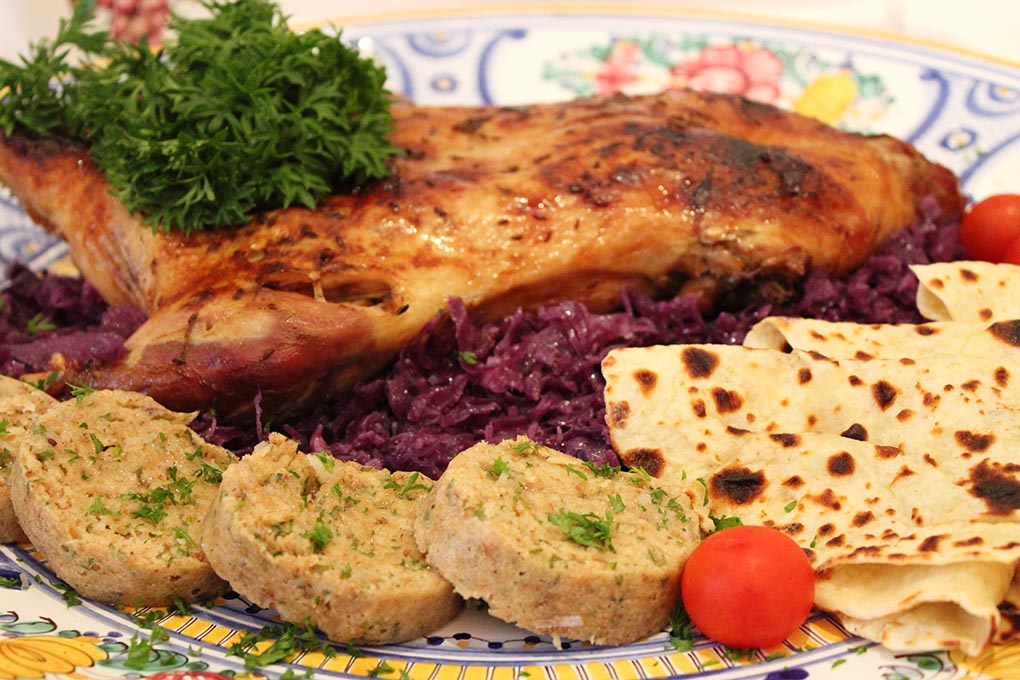
Image: Roasted duck with loksha by Oľga Slivovičová
DD:What are the efforts made to improve/increase the produce from around the world available to the Slovakian citizens?
His Excellency: There is no specific focus in exported and imported goods of the agriculture and food industry. Slovakia as a member of the European Union is a part of the common market of its 28 states and from the point of view of the territorial structure of agro-business, it is dominant that the EU member states continue to consolidate their position. On total exports of agricultural and food products, exports to EU accounted for 96,0% and imports from EU countries to 91,2% of total imports.

Image: Chicken liver pate with cranberries by Oľga Slivovičová
In Slovak imports among the product groups that reached the highest value are bovine, pig and poultrymeat, milk, dairy products, eggs and honey, non-alcoholic and alcoholic beverages and vinegar, furthermore, imports of chocolate, coffee, bakery products, food preparations, cigarettes, rapeseed oil, feed, meat products and maize.
There are, of course, other products exported or imported to/from other markets all around the world. It is possible to state that nowadays Slovak citizens can enjoy a full scale of imported, sometimes also very exotic products and can use them in their own cuisine. The world is open, people travel a lot, taste different food and in case they like it, they prepare it also at home. And there are all kind of international restaurants in Slovakia, where the guests can enjoy food from abroad.
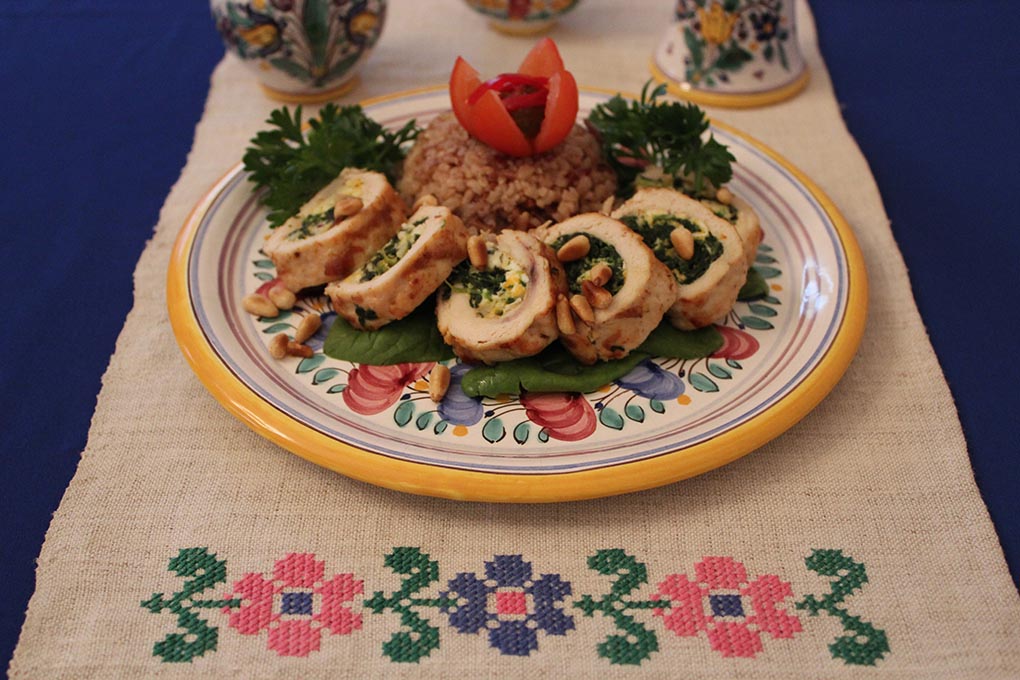
Image: Chicken roulade with spinach by Oľga Slivovičová
DD:How is the government making efforts to introduce Slovakian cuisine/products to the world?
His Excellency: Among promotional tools of the government to introduce Slovak cuisine or products of the agricultural and food sectors to the world, it is possible to mention official presentations at trade fairs and exhibitions of both foreign and domestic ones. By supporting participation in these events, space for the presentation of the production assortment of the exhibitors will be created. There are also all kind of food festivals organised in Slovakia including beer and wine festivals which are very popular among Slovaks and foreigners as well.
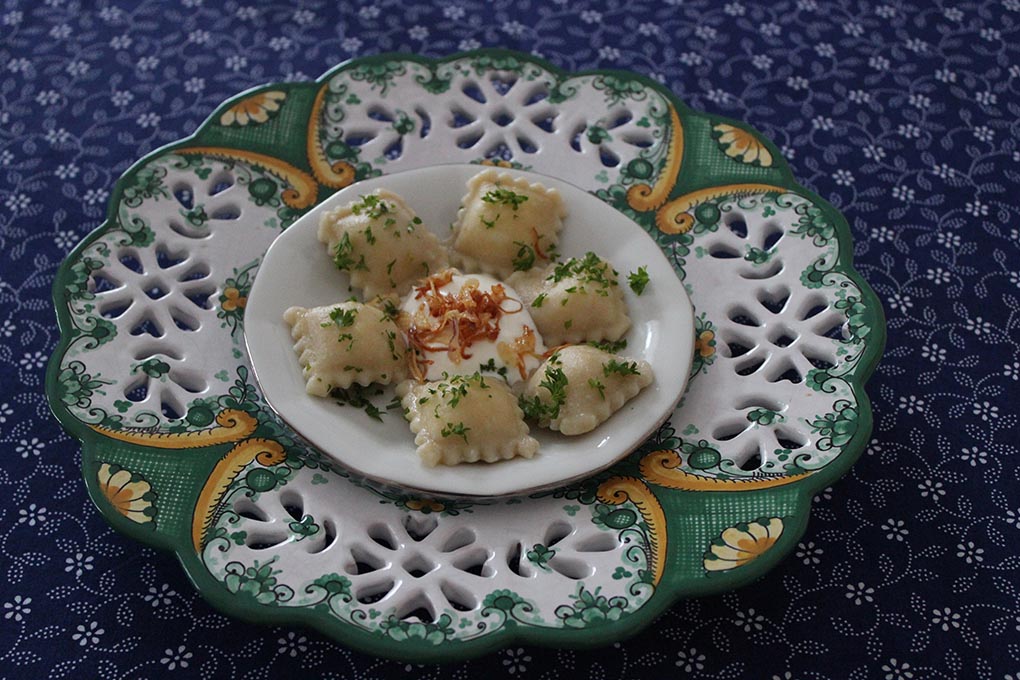
Image: Pirohy with Bryndza (special sheep cheese) by Oľga Slivovičová
A number of traditional Slovak dishes feature on the EU list of protected products. Apart from a few types of cheese and sheep cheese called bryndza, the list includes sweet pastry roll from the town of Skalica, Skalický trdelník (the pastry is wrapped around a tube called trdlo and baked on an open fire). Paprika Žitava known for its special taste and aroma, Bratislavské rožky (Bratislava Rolls), Spišské párky (sausages from the region of Spiš), Špekačky (meat and bacon sausages), and two types of salami.

Image: Christmas Cabbage Soup by Oľga Slivovičová
----------------------------------------------------------
SLOVAK CUISINE
Slovak cuisine is unique and varies slightly from region to region across Slovakia. It was influenced by the traditional cuisine of its neighbours in Central Euroepe and it influenced them as well. The origins of traditional Slovak cuisine can be traced to times when the majority of the population lived self-sufficiently in villages, with very limited food imports and exports and with no modern means of food preservation or processing.
This gave rise to a cuisine heavily dependent on a number of staple foods that could stand the hot summers and cold winters. In the past these included wheat, potatoes, milk and milk products, pork meat, sauerkraut and onion. To a lesser degree beef, poultry, lamb and goat, eggs, a few other local vegetables, fruit and wild mushrooms were traditionally eaten.
All these were usually produced and processed by families themselves with some local trade at the country markets. Wheat was ground, and bread, dumplings and noodles were made from it. Potatoes were mostly boiled or processed into potato dough. Milk was processed into a wide range of products such as butter, cream, sour cream, buttermilk, and various types of cheese etc.Typical pork products include sausages, smoked bacon, and lard. Spices were not widely used, and animal fats and butter were used instead of cooking oils. Main drinks included fresh and sour milk, and beer.
Today, the Slovak dishes use items such as pork, poultry, cabbage, wheat and potato flour, cheese from cows and sheep, potatoes, onions and garlic. Although rice does not grow in Slovakia, it is widely-used and incorporated in Slovakian homes and restaurants. Beans, corn on the cob, lentils, parsley, carrots and other vegetables are often used to create soup dishes and other dishes. Fruit like apples, plums, apricots, peaches, plums and cherries are offered as a side dish alongside the main meal.
Pork, beef and chicken are the three most popular meats used in Slovakian food. Meat from wild animals such as rabbit and venison are widely used in restaurants and also appear now and again in private Slovakian households. Lamb, duck or goose are also popular. Bread is well-known in Slovakia and many Slovaks eat bread for breakfast or for lunch with soup and very frequently for their evening meal.
The best loved drinks include beer, wine and traditional alcoholic drinks Slivovica (made from plums) and Borovicka (made from juniper berries). Beer is hugely popular. There is a huge range to choose from and each region produces its own variety. Wine is a very popular drink in Slovakia. The grapes from which the wine is made grow in the southern areas of the country. Tokaj is probably the best-known label. Mead which is an alcoholic beverage created by fermenting honey has also a long tradition in Slovakia. Contemporary Slovak cuisine is widely influenced by various world cuisines and uses many different ingredients, spices and industrially processed foods.
Chef
Tomáš Táborský answers our questions:
DD: Describe Slovakian cuisine in 3 words
TT:Tradition, fresh ingredients, taste...
DD: What is the essence of Slovakian cuisine?
TT:The traditional taste of our grandmothers’ cooking and the use of high-quality and authentic ingredients.
DD: Do restaurants in Slovakia use imported products? If so, what sort of products?
TT:Restaurants which offer the “honest cuisine” try to use local produce which come from local farmers and suppliers. Of course, restaurants also have to use foreign-produced ingredients that cannot be grown or produced in Slovakia. For example, citrus fruits and quality cocoa beans are not produced in Slovakia.

Image: Potatoes pudding by Chef Tomáš Táborský
DD: What are the deciding factors for chefs in Slovakia when planning a menu?
TT:For me personally, I try to stick to local and mainly seasonal ingredients which are typical and iconic of our country. But, of course, I also like to work with products from all around the world. It is a challenge for me to discover new tastes and then pass on these amazing tastes to my guests.
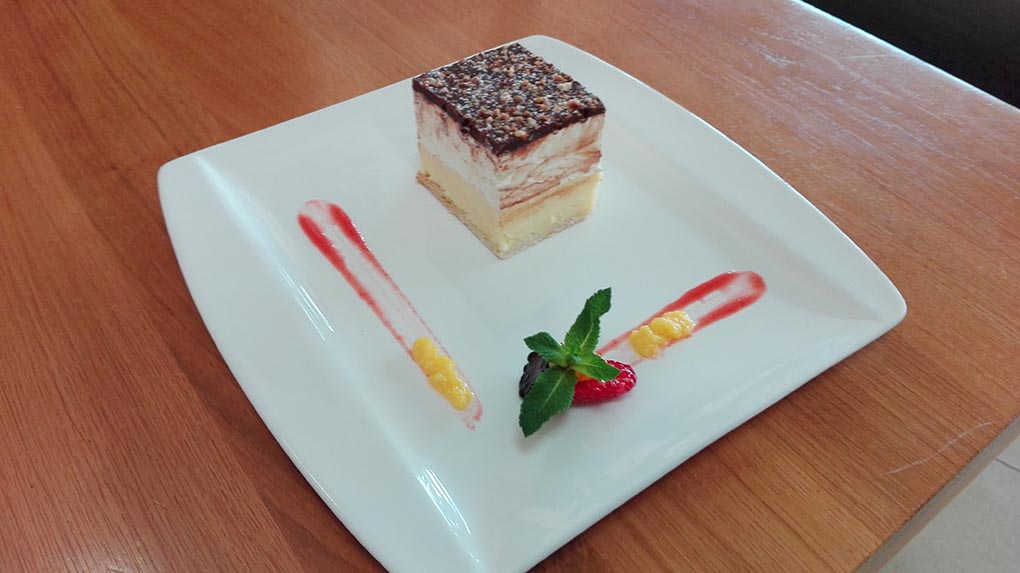
Image: Kremes by Chef Tomáš Táborský
DD: Has the food landscape changed over the last 100 years? If so, what are the changes?
TT:Nowadays, Slovakian gastronomy is trying to return to the traditional dishes from a hundred years ago and transform them into the tastes and dishes of the 21st century, using the most advanced technology. However, our world today is changing so fast and I’m not sure that we can ever again enjoy the same quality, taste and freshness of produce from a century ago. It was a time when people grew all their own food and they valued everything that they had. Today, everything is produced at high speed and livestock is bred behind closed doors. I think that too many people concentrate on making the greatest profit and people do not care enough about what they eat, how it is grown or how the animal, whose meat appears in the supermarket, was fed or lived. I think that this is a problem throughout the world.
DD: Are there any food trends that chefs are following?
TT:Yes, I think there certainly are. Slovakian gastronomy is full of new technologies, new or re-discovered ingredients and tastes and an influence of cuisines from around the world. I am very glad that one of the current trends is the return to using local and seasonal produce which has been grown with the least harmful products. In my work I often use Sous-vide technology, which has also become my hobby. This technology originated in France and it is used in the best restaurants around the world. The advantage of this technology is to maximize the preservation of nutrients, proteins, vitamins, minerals and amino acids in the prepared meal. With this technology we can change the structure of the food, bring out subtleties in flavor and highlight the taste to an extreme level. Thanks to the under-pressure caused by vacuuming, we are able to spread the tastes evenly to each cell of the meal. Personally, I also like to use the elements of molecular gastronomy. This also has a place in today's world, mainly in „impressive“ gastronomy.
DD: What is the future of Slovakian cuisine and are chefs looking to change it in any way?
TT:I’m not sure that any of us have the answer to this question. I’m not sure that I can guess the future of Slovak gastronomy. As I have already mentioned, the world is moving at a very fast pace and no one can predict what is at the end of the tunnel. However, I hope and believe that the beginning of the current trend - to work with local produce and develop a production of health-harmless produce - will strengthen the debate around how people think about what they are eating. Hopefully with time many more people will be able to recognise the difference between ethically-sourced ingredients and mass-produced food. There are many chefs who care about these things and try to move Slovakian gastronomy beyond the boundaries of our time.
We also spoke to
Chef Marcel Ihnačák:
DD:Describe Slovakian cuisine in 3 words.
MI:Slovak cuisine is hearty, typical of a country with strong rural roots...
DD: What is the essence of Slovakian cuisine to them?
MI: Contemporary Slovak cuisine is widely influenced by various world cuisines and uses many different ingredients, spices and industrially processed foods.
DD:Do restaurants in Slovakia use imported products? What sort of products?
MI: Although rice does not belong to the crops grown in Slovakia, it is imported and widely used in the modern kitchen. Potatoes, wheat flour, cow and sheep cheese, cabbage, onions and garlic are the bases of the traditional food in Slovakia. You will often encounter beans, corn, lentils and other vegetables. Also a lot of fruit (apple, pear, peach, apricot, cherry, plum, grape, orange, kiwi, grapefruit, banana, etc.). Pork, beef, chicken and fish are the most popular meats. Less frequently one will be offered lamb, goose, duck, turkey or venison.
DD: What are the deciding factors the chefs consider when planning the menu in Slovakia?
MI: A menu is primarily based on what can be bought in the market. In fact, this should really be the basis for planning for planningspecific dishes. Always consider food in season. Think of available ingredients as substitutes for those off- season..
DD: Has the food landscape changed since 100 years ago and if so, what are the changes?
MI:Over the last century, our eating habits have changed dramatically, with our diets becoming almost unrecognisable to those of our grandparents and great-grandparents. The way we shop, cook and dine has been altered by our attitudes towards food – yet is the modern way the better way?
DD: Are there any food trends that the chefs are following?
MI:Restaurant menus are similar to fashion — some menu items come and go, while others have staying power . 2018 menu trends feature a host of exotic ingredients coupled with old fashion preparation methods. While Many of the 2018 menu trends are an extension of consumers growing awareness around health and environmental sustainability, others focus on adventure-seeking diners who want to experience global flavors when they go out to eat.
DD: What is the future of Slovakian cuisine and are the chefs looking to change it in any way?
MI:Chefs always looking for creative and original ways of presenting food ... The way food is prepared is always changing, so we're learning modern techniques as they come.
We hope that this has enticed you to travel to Slovakia, eat their food plated on their beautiful ceramics and feast! Ladies, do also check out the masterful art of bobbin lace - a tradition of Slovakia.
Read more about Central European cuisine in our
Mar Apr 18 issue.
Sample Central European cuisine as part of this year’s World Gourmet Summit in special dinners featuring a
Hungarian chef,
Polish chef, and
Ukrainian chef.
 When certain cuisines are mentioned, your brain will conjure up the most famous dishes; the flavours you’re craving or of the ones you’ve recently encountered. In Singapore, it would be the Chinese dumplings and chicken rice, the Pernanakan laksas, the Eurasian singgangs, the Indian rotis and curries and the Malay rendangs and satays. Travel up to top tourist destinations in Europe and you’ll get to taste French bouillabaisse, onion soup, coq au vin; Italians with their Parma ham, truffle risotto and pastas; numerous German sausages and berliners; Spanish paellas and churros… the list is endless. Now, those are mostly on the western side of Europe. What about Central Europe? Any dishes spring to mind? If not, that’s a real shame. Keeping this factor in mind, the World Gourmet Summit (WGS) 2018 has decided to highlight some parts of Central Europe, with their theme: “The Discovery WGS.” We’ve decided to shadow this and spoke to six countries within Central Europe. The ambassadors gave quotes on how their nation’s agriculture is developing while the chefs share about the gastronomic scene.
When certain cuisines are mentioned, your brain will conjure up the most famous dishes; the flavours you’re craving or of the ones you’ve recently encountered. In Singapore, it would be the Chinese dumplings and chicken rice, the Pernanakan laksas, the Eurasian singgangs, the Indian rotis and curries and the Malay rendangs and satays. Travel up to top tourist destinations in Europe and you’ll get to taste French bouillabaisse, onion soup, coq au vin; Italians with their Parma ham, truffle risotto and pastas; numerous German sausages and berliners; Spanish paellas and churros… the list is endless. Now, those are mostly on the western side of Europe. What about Central Europe? Any dishes spring to mind? If not, that’s a real shame. Keeping this factor in mind, the World Gourmet Summit (WGS) 2018 has decided to highlight some parts of Central Europe, with their theme: “The Discovery WGS.” We’ve decided to shadow this and spoke to six countries within Central Europe. The ambassadors gave quotes on how their nation’s agriculture is developing while the chefs share about the gastronomic scene.





